#i love his classic punk design first and foremost
Note
Hey did the comics ever explain outright why Conner stopped being punk? He was in the jeans and t shirt in the first issue of Titans and the comic prior he wasn't???? Did something happen to him to make him stop?
Hello and thank you for this question, I apologize that this is not a simple answer because Kon's fashion, as is his personality, isn't simple to answer because his shift in fashion is a story of his sense of identity and purpose.
To get to the point of your question Conner's leather jacket and "look" was not part of his character for quite some time prior to Teen Titans. I will extrapolate on that in a while but for right now I feel that some things need to be settled about Kon because there's a lot that people just get wrong about him.
I feel it important to remember that Kon didn't really go out and choose the leather jacket and "punk" style all on his own. There is a misconception that some fans have that Kon went out and sort of assembled his iconic look all on his own to be a direct rebel and to deviate from being like Superman to "piss Clark off." This is extremely far from the truth and is fanon.
What actually happened is Kon broke out of his CADMUS tank with the help of The Newsboys; he was already dressed with his ear pierced (yes). Then his iconic leather jacket was given to him by them.

"Until you get some other clothes or something" HAH.

Adventures of Superman #500
So he's fresh out of his tank, he's pumped full of purpose, he's out in the world, and he just looks like this pre-made even with the hair and belts. In some flashbacks with him in the tank his earring is replaced by a tag (yes) but when he does officially first show up his iconic "punk" style is almost very nearly complete and it doesn't change (officially) until Superboy #83. Kon didn't really go out and choose this look, he came out like this and just... stuck with it.
This is not to say that this is not Kon, he could have at any time dropped the look. But Kon didn't. This is his uniform.
Another point to note about Kon that is extremely important is that unlike Tim, Bart and Cassie he did not have a civilian identity and it was extremely RARE that he ever was in civilian clothes beyond some underwear or a swimsuit. His civilian clothes that he did sport were fairly... tame, and not punky in the slightest. Kon looks just like a typical 16 year old kid.

Superboy #75
My whole point here is that Kon WAS Superboy. Just Superboy. SB. He did not even have a name until Superboy #59, until then he just went by Superboy. His uniform was so intrinsically tied to who he was he didn't have a real need for any civilian clothes. His "style" was just Superboy because he did not have an "off switch."
Trust me this is important.
Back to the jacket... Because the jacket is important and is part of his uniform and his self identity.
There was a brief period of time in his comics when he completely ditched his iconic look because he lost all of his powers in response to the resolution of the Sins of Youth anthology and Tana being murdered by Amanda Spence.
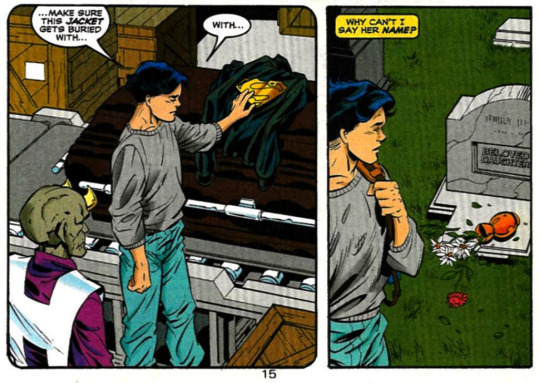
Superboy #75
The original leather jacket is actually buried with Tana. And after that he takes on a temporary new look.
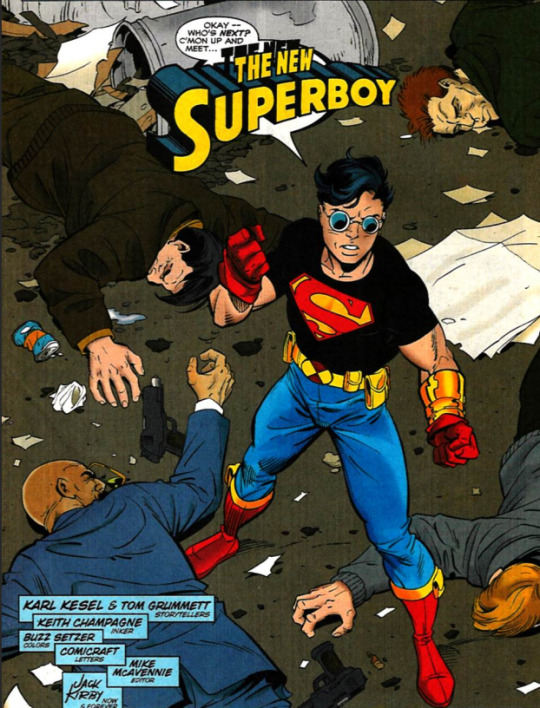
Superboy #76
This is the first time we see him in a "jeans" and t-shirt ensemble and as far as we are able to tell he picked this out all on his own. Kon actually really kicks ass during this time and he was content with losing his powers and was legitimately looking forward to living like a regular person.
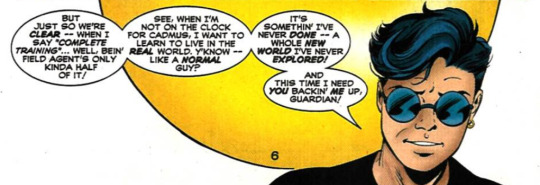
Superboy #76
Well, this did not last long. Kon got his powers back and he got a new leather jacket and his plans for living in the real world as a "regular person" just fell through. Kon was back to being Superboy.
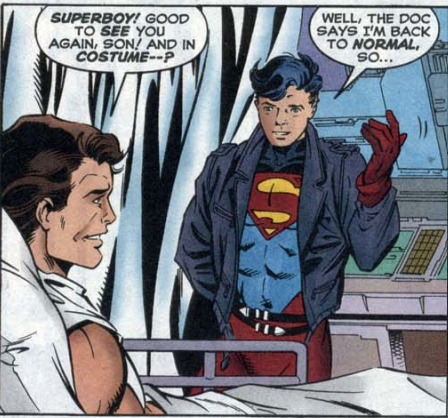
Superboy #79
Kon's "normal" is Superboy so he was back to the look but with everything that happened he just never was quite the same... PTSD
Kon remains back in his original outfit until Superboy #83 when the writing takes a turn into the lighter side...
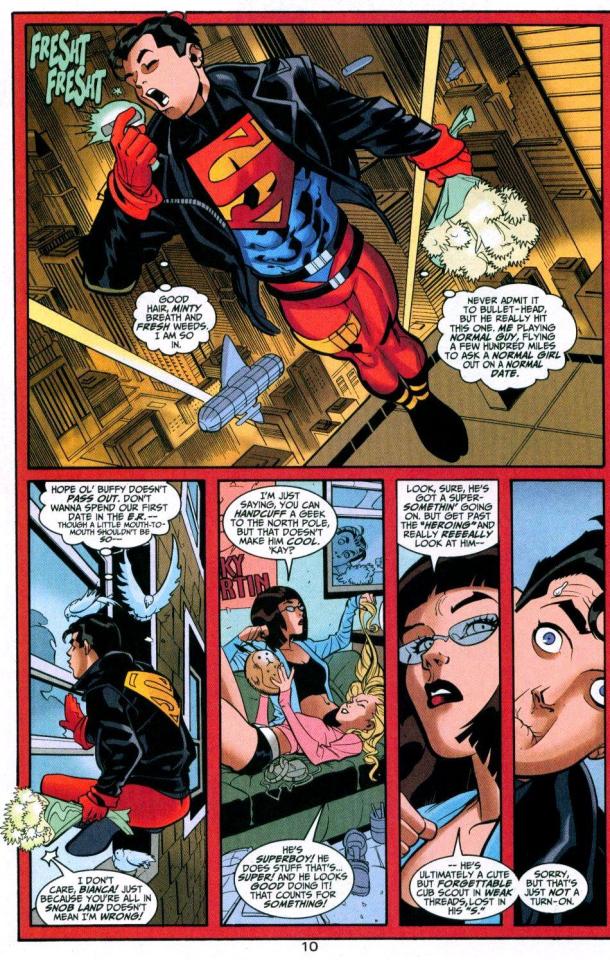
Kon comes to the conclusion that he's no longer cool, hip, relevant and decides that he needs to totally reinvent himself and his uniform. He enlists help from Bianca (the brunette who comes off as a major bi) to help him get his swagger back.
After a comical montage of going through outfits and watching an exceedingly unhealthy amount of current television Kon finds himself a new look that he remains in for the rest of his series and Young Justice up until Teen Titans.

Naturally, something like this cannot be so cut and dry and we get to the root of the "problem" Kon was facing.

Superboy #83 is the first time we see Kon ditch the leather jacket and the earring for good in favor of his new suit and jacket and this was well before Teen Titans started.
While Kon wears this particular outfit he is still without that secret identity and his life is complete utter destructive mayhem as he lives openly without an off switch as Superboy. It is not until his final issue of #100 that Kon is set up by Clark to live with Ma and Pa Kent on their farm as Conner Kent (this honestly should have happened much much sooner).
This marks the end of Kon's solo series but he continues to make appearances in Young Justice in this suit until that series completed itself and was replaced by Teen Titans where we finally see Kon as Conner Kent sporting his jeans and a t-shirt as he lives in Smallville which he loathes for a while until it grows on him.
Kon's entire purpose of moving to Smallville was to slow down and right from Clark's mouth to "Start a new life." (Superboy #100) So he completely reinvented himself again to fit in with that civilian identity which he never had before. It's hard on him at first but eventually he starts to come around to loving Smallville.
There's a lot of debate and evidence you can make about Kon and if he is truly or ever was punk; was him living in Smallville "closeting"; was his shift to jeans and a t shirt really him or was that something he felt was necessary in order to find himself?
To answer your question of what made him "stop being punk" was he finally got an off-switch. Kon will always be Kon and by the time he gets that t-shirt and jeans I feel like he knows the clothes don't make him, he makes himself.
#kon el#conner kent#superboy#superfam#fashion#meta#i love his classic punk design first and foremost#i live for that design and i live that kon's default settings is that jacket#so i do appreciate rebirth giving him back that look#the original series is a mess#i hope this makes sense#i wrote the last half while nearly falling asleep so if anything doesn't make sense blame waking up at 6 and going to bed at 11#i hate that tumblr still won't let you upload more than 10 images#mine
150 notes
·
View notes
Text
Why It Worked: Kid Cosmic

Kid Cosmic is an animated action superhero comedy show created by Craig McCracken. Released on Netflix on February 2, 2021, the show follows the adventures of a young boy who tries to live his dream of being a superhero when he comes into possession of 5 stones of power. The show features the voice talents of Jack Fisher, Amanda C. Miller, Lily Rose Silver, Fred Tatasciore, Tom Kenny and Keith Ferguson. The show recieved critical praise, boasting an 8/10 average rating on IMDB and was dubbed one of the 13 best TV shows of 2021 by LA Times. When I first watched the show, I was absolutely blown away by the first season. Having recently finished watching the show's final season, I can confidently say this is among my favorite cartoons of the 2020s thus far. I'd be more than happy to talk about why in this latest addition of Why It Worked.

Premise and Execution: The show has a simple yet very interesting set up: a kid who loves superhero comics tries to live his dream once he comes into possession of 5 cosmic stones of power. He's joined by his waitress friend Jo, his 4 year old neighbor Rosa, his grandfather Papa G and his cat Tuna Sandwich. The main struggle Kid has to overcome first and foremost is that things don't play out like they did in his comics. This is where the show truly shines as it subverts many conventional and classic superhero tropes in clever and unique ways. From Kid learning to accept that his team isn't what he had in mind to not every alien being a major threat, this show takes advantage of the fact that this is not a power fantasy while at the same time delivering some really good messages about helping people, working together and making sacrifices. This show also has really funny moments such as Kid not being able to control his flight ability to Rosa unknowingly killing a bunch of aliens to one of Papa G's clones being traumatized, this show provides lots of laughs throughout its 24 episode run. This show also has a bopping soundtrack by Adam Bean with heavy garage punk songs that are upbeat and catchy. Lastly the show has some really good animation. It may look like a fully colored animatic, but that's what makes it so unique and amazing. The characters have differing body times, expressive faces and complimentary clothes. They're also designed in a similar style to comics like Dennis The Menace such as having black dots for eyes and darker outlines. The character animation feels natural and the action scenes really pop with sharp speed and excellent cinematography. Backgrounds are also well detailed with the diner feeling like it has a long history, Papa G's junkyard being full of supplies and the desert looking like, well, a desert. The show's premise was good in its own right, but the execution makes the show stand out for the better.

Cast and Characters: Kid Cosmic had a relatively small cast of characters but that's not a detriment because they're all well written and interesting in their own write. Starting with our titular hero, Kid is a happy-go-lucky boy who's a huge comic book fan that gets frustrated when things don't work out the way he plans. He can be in over his head at times, but his heart is most certainly in the right place. Jo, the waitress at the local diner, is cares about Kid's safty and tries to make sure he doesn't get killed or worse her Mom find out about their antics. Rosa is a playful little 4 year old who wants to have fun with Kid, much to his detriment. Thankfully they grow to respect each other and she becomes a really helpful ally. Papa G is such a chill and caring grandfather to Kid and is more than willing to help him, no questions asked. He also teaches Kid some very sage advice such as his famous mantra "Freaking out, breathe it out." Tuna Sandwich is a good cat that tries to make sure Kid is saved from certain doom. Then there's Chuck, an alien invader who starts out as a villain in the first couple episodes before begrudgingly becoming an assest to the team. He's a snarky and cynical alien who wants the stones of power for his own personal gain, but mellows out later on in the first season. Other characters that make notable impacts, particularly in the later seasons, include Flo (Jo's Mom who runs the diner), Rosa's parents Ramona and Carlos, Carla an old biker, the mysterious biker in black, and Fantos, the main antagonist of seasons 2 and 3 who an immature fanboy of the planet killer Erodius. These characters are brought to life wonderfully by the voice cast directed by Sam Riegel. Jack Fisher does an amazing job voicing Kid as he makes him sound like such an excitable kid who wants to live out his dream. Amanda C. Miller did such a good job voicing Jo, making her sound like a caring older sister to Kid. Lily Rose Silver was stupendous as Rosa, making her sound and act just like a 4 year old. Veteran voice actors Tom Kenny, Keith Ferguson, Fred Tatasciore, Grey Griffin and Cree Summer bring their A game and bring their respected characters to life. Papa G sounds perfectly chill and wise, Chuck sounds exactly like a cynical alien villain who failed, Carla and Ramona sound very distinct from one another, Tuna Sandwich sounds like an old cowboy and Queen Xhan sounds very calm but full of authority and wisdom. Also gotta give credit to Bobby Moynihan as Fantos because he made him sound like such a manchild while also still msking him an imposing threat to our heroes. All the characters are so well written and full of life and the actors who played them did excellent jobs.

Where It Falters: While I think the desert look really good, it's still not the most visually interesting place to be for long periods of time. I also wasn't too impressed with Erodius being an actual planet. I suppose it makes sense with what they were going for but it's still rather dull looking.

Conclusion: Kid Cosmic is an absolutely amazing animated show. With an astounding cast of characters, excellent writing, really funny humor a killer soundtrack and great animation, this show truly stands as one of Netflix's best shows. If you haven't seen the show yet, definitely check it out. There's a whole bunch of surprises I didn't mention in this post that I think you're really going to like. Thank you so much for reading and I'll see you soon ;)
#reblog#share#like#follow#animation#comedy#netflix#action#superhero#kid cosmic#why it worked#craig mccracken#netflix animation#kid cosmic and the local heroes
5 notes
·
View notes
Text
Ray Farrell on music and his time at SST, Blast First, Geffen and many more.
Ray Farrell has had a lifetime surrounded by music. First as a fan as a young kid and then eventually working for a series of record labels. He’s obviously a fan first and foremost as you can tell by reading below. It also seemed like he was there at the beginning of some major music scenes happening.
I had met Ray very briefly at one of the A.C. Elks hardcore shows that Ralph Jones put on in Atlantic City in the Summer of 1985 though Ray doesn’t remember it (honestly, a bunch of us were standing in a circle and chatting so I’m not even sure if any proper introductions were done).
Anyway, knowing some of the record labels that Ray had worked for I wanted to hear the whole story. I contacted him and shot him some questions and he was more than happy to elaborate and let us know where he’s been and where he’s going. Take it away, Ray!
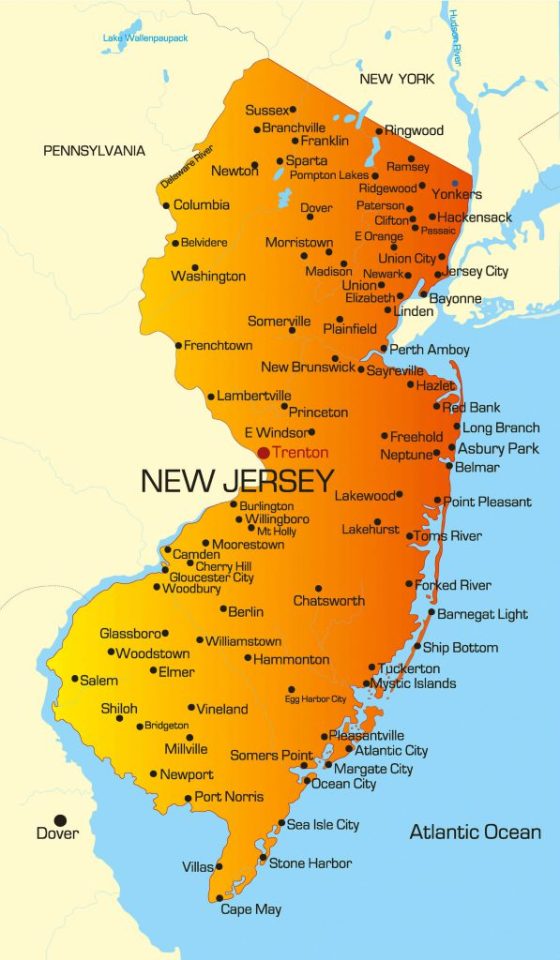
Where did you grow up?
RF-Jersey City and Parsippany, New Jersey in the 60/70’s. I have two younger brothers.
What did you listen to first…classic rock or stuff earlier than that?
RF-Rock wasn’t classic yet. My earliest memories of music are my parents’ modest collection of 45’s and grandparents’ 78’s. My mom had a handful of singles on Chess and Satellite (pre-Stax) that she said fell off a truck. We rented our house from a family connected to the mob. The records probably came from them. My mom and her sisters often sang Tin Pan Alley era songs at family gatherings. Harmony was encouraged!
Some records I heard as a toddler stayed with me forever. Lonnie Donegan’s “Does Your Chewing Gum Lose Its Flavor?” is a skiffle classic. Chuck Berry’s “Guitar Boogie” and “Last Night” by the Mar- Keys are still favorites. I remember being spooked by the overblown production of the “Johnny Cash Sings Hank Williams” e.p. on Sun Records. In the mid 60’s, my mom had top 40 radio on in the house unless my dad was home. When I was in kindergarten, a high school neighbor in our building babysat me for a couple hours after school a few days a week. Her girlfriends came over regularly. They listened to a lot of doo-wop, which I still love today. The babysitter and her friends taught me how to slow dance, even though I wasn’t nearly a full grown boy. J
My best friend in 7th grade was a Beatles fanatic and we immersed ourselves in decoding clues to the “Paul McCartney Is Dead” gimmick. That was a brilliant scam and a fun short term hobby. It was a deep dive into The Beatles music as a junior music detective. By the time I started buying records, The Beatles were on their way out.
I happily lived for many months on only three albums-
CCR’s “Bayou Country”, Iron Butterfly’s “In A Gadda Da Vida” and the Beatles “Sgt. Pepper.” I joined the Columbia Record Club. I got the first twelve albums for one buck. That was a popular scam. Those first twelve records shaped my taste because they were the only records I had. I didn’t know what to order but I chose very well in retrospect. After that, I bought a lot of records. I didn’t smoke, but many of my friends did. A carton of cigs cost the same as an lp- 5 bucks.
I learned in 7th grade that if I knew the songs that girls liked, we would have something to talk about. Girls loved Tommy James and The Shondells and The Rascals. I still do! I had a wider range in music taste than most of my high school friends. Everyone in my extended circle loved the Stones, Neil Young and the Allman Brothers. In a tighter circle we were into David Bowie, Lou Reed, Sparks, Todd Rundgren etc. I loved Mountain, Led Zep, Hendrix, Budgie, The Kinks, Alice Cooper, Sabbath. At first, The Stooges seemed too deep and serious for me. A little scary because I thought if teenagers felt like this all over the world, I’m doomed. I bought the album with “Loose” and played that song for weeks before listening to the rest of it. The girl next door had Iggy’ s “Raw Power” album the week it was released. When glam rock was happening in England, there was a weekly NYC radio show that played the Melody Maker Top 30 singles. I was fascinated by T.Rex, Slade, Hawkwind. I don’t recall if prog rock was a tag yet, I knew that I didn’t like songs that rambled on for more than 7 minutes. There were exceptions of course- some King Crimson, Yes, Mahavishnu. I was impressionable. Radio station WBAI hosted “Free Music Store” concerts with local acts. One show was a keyboard group called Mother Mallard that had banks of synthesizers on stage. They were similar to the music of Phillip Glass and Steve Reich, who you would only hear on that same radio station. I talked myself into buying their records, but it took years to comprehend them. I was too young to be listening to such serious stuff. I played soccer and ran track for a couple years. During meets at other schools, I made friends. At parties I heard Issac Hayes, Bohannon and James Brown records. Brown was all over top 40 radio. Rhythm guitar was my jam! Soul and funk records were best for that. I spent many nights listening to AM radio. The signal travels farther at night, so I’d listen to stations far away. It didn’t matter what kind of music it was. Some of my relatives had short wave radios. I was more interested in radio production than short wave content. The production quality has not changed much since then. It often sounds like broadcasts trapped in the ether for the last 30 years.
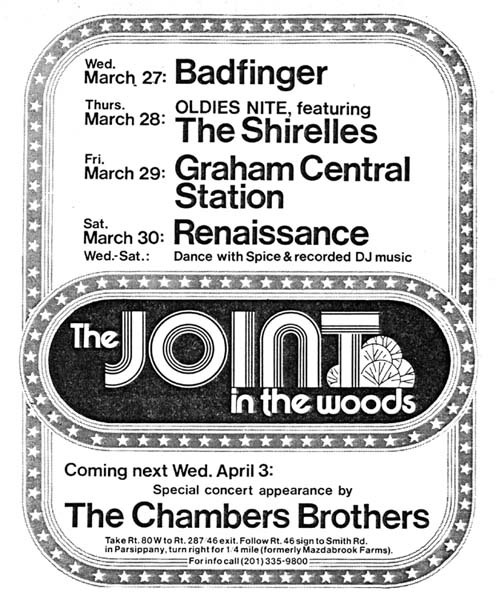
While I was in high school, it was common for local colleges to host rock and jazz concerts for low prices, sometimes free. The schools had to spend the money sitting in the student union coffers. There was a live music club in my town called Joint In The Woods. The venue began as a banquet hall that doubled as a meeting hall for Boy Scout Jamborees and the like. When it became the Joint, it was a disco. The first night of live music was a show with Iggy & The Stooges. The regular disco patrons were pissed! The guys were mostly goombah’s in Quiana print shirts and bell bottoms. Three or four guys smacked Iggy around after his set. Sure enough, he played Max’s Kansas City the next night as if nothing happened. Because of this club, touring bands were suddenly playing in my town. Badfinger, Roy Wood’s Wizzard, Muddy Waters. The NY Dolls were scheduled but didn’t show up. Springsteen was often an opening act. The N.J. legal drinking age had just lowered to 18. It was a great time. I was still in school, so I wasn’t staying out on weeknights.
I was determined to learn NYC music history by hitting all the Greenwich Village clubs and talking to the owners and bartenders. It didn’t matter what kind of music they specialized in- I was into the vibe. There were occasional scary nights parking near CB’s or jazz spots in that neighborhood. Folk music was on FM radio at the time. A high school friend booked a local coffee house called Tea & Cheese. Mostly locals and ambitious tri-state artists. Martin Mull, Aztec Two Step, Garland Jeffries. Some of Lou Reed’s touring band, The Tots, played there. I went to all kinds of record stores, mainly those that sold rock imports and cutouts. I was fascinated by the street level buzz of a record. In ’74, I heard dub reggae for the first time. The only stores to get that music were in Queens because there was a strong West Indian community there. It may have been the “Harder They Come” soundtrack that got me started. There was a “pay to play” radio station in Newark - WHBI. DJ’s had to buy their airtime. Arnold “Trinidad” Henry had a weekly show playing new calypso and reggae. He was more into calypso than reggae. A lot of calypso was political and comical. Arnold was fascinating! There was often a personal crisis he’d talk about on the air. My favorite incident was when he said that his life had been threatened during the program, so he locked himself in the studio.. Someone called the cops. They convinced him to unlock the door. He just wanted more airtime. Arnold played the first reggae dub track I’d heard- full dub albums were a new concept at the time. Most dub was found on the flipsides of reggae 45’s. One of the shows sponsors was Chin Randy’s Records in Queens. I trekked out there by train to buy my first dub records. That was a trip! Randy Chin’s family went on to start VP Records.
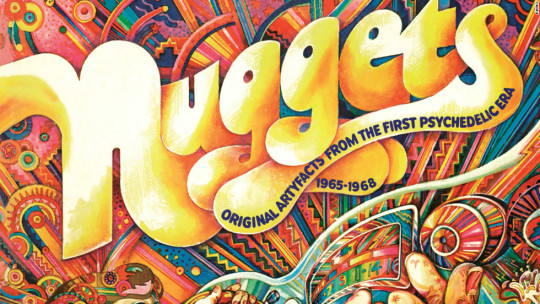
What was the first alternative/independent music you got into? How did it happen (friends? older siblings?)
RF-The term “punk” as a music style hadn’t been coined yet. I vaguely recall equating “punk” with the great “Nuggets” compilation or something Greg Shaw might have writ in Bomp Magzine. I didn’t identify labels as independent. I knew that if the label design was simple and the address was listed, it was probably a small company. There were plenty of record stores carrying obscure stuff. I bought import records from a few NYC stores. I took the bus in until I was old enough to drive. One store Pantasia, was up in The Bronx. I went there one Christmas eve day to get the import of the second Sadistic Mika Band album. The clerk talked me into buying the harder to find first album as well. He said it sounded like Shel Talmy produced it. I knew who that was and it was a revelation to talk to somebody in a record store at that level. That is what a record store should be! I read Phonograph Record magazine, Bomp and Trouser Press regularly. Patti Smith and Television self released their debut singles- those are the first “indie” records I bought, followed by the first two Pere Ubu singles. I remember hearing the Modern Lovers’ “Roadrunner” from the Bezerkley Chartbusters comp on WFMU and thinking that there must be more music like that. It was refreshing.
Seeing Patti Smith and Television perform at CBGB’s changed my life. I connected the dots. I had BÖC albums on which Patti had co-writes. She had a poem insert in Todd Rundgren’s “A Wizard, A True Star” album. She read a Morrison poem on a Ray Manzarek lp. She wrote for rock music mags with distinctive style. I read a brief story about her in the Voice and went to see her do her annual Rock N’ Rimbaud show. Shortly after that she and Television played CBGB’s for six weekends in early ’75. Both bands were really great. Patti didn’t have a drummer yet. Richard Hell was a big inspiration to me. He looked cool. He played bass like he just picked it up the month before. That was a new concept. Television changed bass players in the middle of the residency. Television was the first band I saw with short hair and they dressed like teenage delinquents circa 1962. The CBGB’s jukebox had a good number of 60’s garage records. In my head I conceived Television to be inspired by that music. Made sense to me- Lenny Kaye, who assembled the “Nuggets” comp, is in the PSG. When I went back to see Television headline, The Ramones opened. Seeing The Ramones again, Talking Heads opened. It seemed like the streak of seeing great new bands would not end. They were distinctly NYC sounds. They could not have merged anywhere else. I remember avoiding the band Suicide because I didn’t think the music could be good J. Bands like Tuff Darts, Mumps and The Marbles opened shows but I wasn’t thrilled by them. A CBGB’s band that doesn’t get mentioned much is Mink DeVille. They wore matching outfits like they were playing a low budget Miami dive in 1962J. The club still had the small corner stage. The p.a. was ok and the bands had small amps. The music wasn’t loud in a “rock” way. You could sit at a table right in front of the band. Although we consider the club a birthplace of punk, the club showcased local bands that had been around for a while. I think the club upgraded the p.a. once before building the big stage. I realized at that point that when a band was great or at least interesting live, the records were basic documents of the band’s sound.
What was your first job in the music scene/industry?
RF- Before realizing I wanted to be in the business, I hounded import mail order guys on the phone about non-lp b-sides and albums that weren’t released stateside. I was fascinated by the process. Why were some records not in stores even though they had local airplay? My dad did not listen to much music, but he had an army buddy that made a living in Al Hirt’s band. He came to our house once. He gave my dad a copy of John Fahey’s “After The Ball” album, which he played on. I liked his stories about the session man side of the business. Fahey treated him well. I was generally shy, but when it came to music I would approach anyone I thought I could learn from. I heard horror stories about the music biz in NYC but learned later that those were a mob related labels. At the time, I thought the entire NYC music biz might be that way. I planned to move to California anyway. In high school, I go-fer’d at local Jersey radio stations and talked my way into meeting a few top FM radio dj’s. I thought I wanted to be a professional dj, but my dad wisely talked me out of that. The itinerant radio jock life would not be for me. It was a racket.
In ’76, I took a long low budget cross country trip with my high school sweetheart. Along the way, I stayed in Memphis for three weeks with a cousin who was stationed at the Millington naval base. Got a job at a hip movie theatre that served liquor. I found Alex Chilton in the phone book and spent an afternoon talking with him. I wasn’t yet legal drinking age in Tennessee. It amused him that a fan showed up in his town who was not old enough to drink. En route to Cali, Tulsa, OK was on my route to find Shelter Records and studio , but it shut down and the label moved to L.A. At the time, Dwight Twilley’s “I’m On Fire” was a radio hit. I didn’t think there were still bands like that. Twilley was from Tulsa, but had moved to L.A. by that time.
When I arrived in L.A. I visited small label record company offices. A few offered me jobs or references. I spent two weeks crashing at the Malibu house of a distant family friend. I didn’t want to live in L.A. but I was encouraged by the opportunities. I got a job at the famous record store- Rather Ripped in Berkeley, CA.
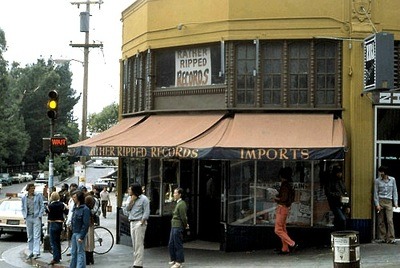
Patti Smith told me about Rather Ripped before I left Jersey. In ’75, she and her band went to California for shows in L.A. and Berkeley. The northern Cali shows were set up by the store. She did a poetry reading there. This is well before “Horses” was released. I bought a couple records from the store’s Dedicated Fool mail order service. They had a monthly catalog on newsprint. Thousands of records in tiny font. Every record was described with a few words. This is 1976 and punk rock was just getting started. I worked as a prep cook in a charcuterie associated with Alice Waters’ famous restaurant Chez Panisse. The proprietor knew the record store owners. I wasn’t actively looking to work there, but I talked about music all day every day. They fast tracked me for an interview. Because of a scheduling mistake, Tom Petty interviewed me for the job. His first album just came out and “American Girl” was close to being a hit single. The band came to the store before a local show. Tom overheard the owner apologizing for not being able to do the interview, so he offered to conduct it. It was great. I knew all about his label, Shelter Records. I deliberately avoided talking about The Ramones and Patti Smith because punk was new and against the grain. At the end of the interview Tom told the owners that if he lived in Berkeley, he’d buy all his records from me. The store owner still had to interview me formally the next day, but I knew that I nailed it.
It was owned by two dynamic gents that were connected to Berkeley society and Bay Area journalists. They weren’t typical record store guys. They celebrated the 70’s in the moment. They held court with well known music scribes, musicians, dj’s. They were good friends of The Residents. Perhaps my strangest story is meeting The Residents with the Rather Ripped owners at a S.F. Irish bar that specialized in Irish Coffee’s. I had only recently heard of the group, so I was not cognizant of their marketing myth. At the bar, we were with our girlfriends and wives. One of the Residents tried to convince me and my gf to go back their place for a hot tub session. I laughed out loud and said “geez, what a bunch of hippies”! We didn’t go. In retrospect, I should have gone on the condition that they wore eyeball heads in the tub. At that time, The Residents rarely performed live, but they did in 1975 for the store’s birthday party. The early Bezerkley Records (Jonathan Richman, Greg Kihn) was distributed to stores through Rather Ripped. Their office was a few blocks away. At the store, each employee had unique music taste and expertise. Pop music was changing rapidly with a new energy. Some of us were tapped into it. We all had to know the key new releases in every genre because we were tastemakers. Major labels would beg us to do window displays for new releases. But if they could not find a store employee that liked that artist, it was no go. So, no Pablo Cruise window display. We weren’t against major labels, but we put a lot of energy into selling the ton of music that we loved. Our focus was on imports, indies, promos and cut outs where we could get a good price mark up. We had a rare record search service with customers all over the world. We’d find rare records through trade-ins and by combing record stores all over the state.
There were a few import distributors, but they weren’t hip to many small run U.S. independent releases. That was understandable because bands didn’t often press enough records for a distributor to get excited about. In other words, why spend half your day hunting down records that were only pressed in small quantities. Just as they start selling, you’re out of stock. There gonna sell a hell of a lot more Scorpions’ picture discs! As always, some distributors financed exclusive re-pressings of records that had momentum. The only way to get records like Roky Erikson’s “Two Headed Dog” single or The Flamin’ Groovies’ “You Tore Me Down” 45 was directly through mail order. I wrote to label addresses listed in Trouser Press and fanzines to buy direct in order to sell them in the store with no competition. Major label sales reps didn’t prioritize us because we didn’t shift bulk units of the hits. However, we were so plugged in to the lesser known artists that we were a good place for record companies to try and start a buzz. We could swell 50-100 of a record that all the other stores sold a handful of. Bands showed up at the store while touring. Springsteen bought Dylan bootlegs from us by mail order. Patti Smith’s manager Jane Friedman used the store as a home base when Patti and John Cale came through the area.
Berkeley is in the East Bay of the S.F. bay area. A few months after starting at Rather Ripped, I realized that the city had a rich music scene well before punk /new wave started. There was Fantasy Records, a well known jazz r&b label but best known for CCR; Arhoolie, Solid Smoke, Metalanguage; the contemp classical labels- Lovely Music and 1750 Arch; folk and blues labels like Takoma and Olivia. Of course, bands like Chrome and others started labels to release their own music. Ralph Records was started by The Residents, and they began signing bands. Rather Ripped was also a center for improv, electronic and meditation records.

In ’77 or ’78 I joined the nascent Maximum Rock N Roll radio team. This was well before the magazine. In the early days there were weeks when we didn’t have enough new punk records to fill the two hour weekly show. Tim Yohannon was all about energetic, real rock n roll, so he filled in the program with records by Gene Vincent, The Sonics etc. BTW, Tim applied green masking tape to the three closed sides of every record he had. He gave me a Mekons double single he decided he didn’t like. It was in a gatefold sleeve that he sealed shut with his green tape! Sometimes he re-designed the cover art…never for the better. He made his own pic sleeves for 45’s that didn’t have them. Bands would stare at their own records in bewilderment. Tim was archiving the records of the entire punk and hardcore movement worldwide.
Eventually, Tim brought in Ruth Schwartz, and Jeff Bale as co-hosts- both great people. Jello Biafra was a frequent guest. Tim assembled the “Not So Quiet On The Western Front” lp and later organized syndication for the radio show. I remember hearing the first Disorder ep and thinking -this is the future! J It was exciting. But soon, most hardcore records sounded alike to me. It was like- “Do you want more fries with your fries?” I went to plenty of live shows without knowing a lot about the bands playing them. I was happy when the fashion trended away from jackboots to sneakers…getting a boot kick to the head in a stage dive could be brutal. I didn’t see a lot of skinhead violence at shows, but I know it was changing the scene.
San Francisco and Berkeley were important music centers, activist meccas as well as creative artistic and intellectual hubs. Yohannon had history as an activist. He identified with public protests for causes & social issues. For many teenagers, punk rock was a rite of passage. I think it changed a lot of kids’ lives for the better. The overriding message was to be civically aware of what is going on around you and what affects your life.
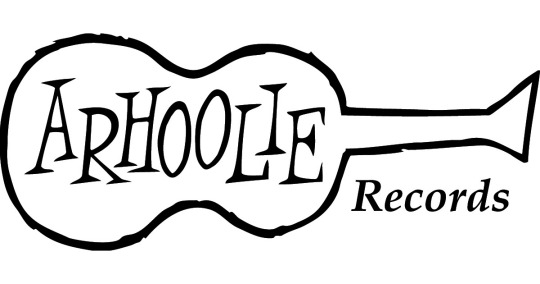
Tell me about your time at Arhoolie Records. Where was it located?
Rather Ripped’s owners had a falling out and the remaining owner just wanted to sell records and antiques with his wife. He moved it to a nearby city. Just before the store closed, he told me of an open position at Back Room Distribution, a division of Arhoolie. It was in El Cerrito, a small town north of Berkeley. Chris Strachwitz, the owner of Arhoolie is a legendary record man. He recorded many of his early blues albums with a tape recorder in his car. He owned the legendary Down Home Music store in the same building. Separated by partition behind the store was Back Room. It was an indie label distributor for blues, folk roots music. Rounder Records was still a new label at the time. I gotta admit, when Rounder issued The Shaggs “Philosophy Of The World’ I was in seventh heaven. I worked primarily for the distributor, grooming to be a sales rep but I spent a lot of time in the store. At first, I didn’t yet relate to blues and country music. But there were a lot of touring artists in those styles making a living. It was a strong network of clubs, fans, radio shows and press that fueled it. The store had an incredible selection of obscure 50’s/60’s rockabilly and garage band comps. The Cramps were my favorite band at the time. The rockabilly comps mostly on a the Dutch White Label, were treasure troves of insane songs. My heart was in new music- whatever you wanna call it, punk, new wave, art music. That’s the business I wanted to be in. I used my time to learn more about distribution operations. The people that worked at Arhoolie and in its community were fun music heads. There were a lot of good musicians among them. It was a great time to live in Berkeley.
What was next, Rough Trade and CD Presents? Was that in San Francisco? I went to that Rough Trade store a few times and it was an amazing store.
I knew folks from Rough Trade UK because I bought imports from them to sell @ Rather Ripped. When they wanted to open in the U.S. they contacted me, but at the time the wage was low and there wasn’t enough space to work. I was interested in working in the distribution division, not the store. They speiled something about it being a socialist business. I stayed at Arhoolie for a little while longer. In the meantime, I was offered my own weekly late night radio show on Pacifica’s KPFA in Berkeley- same station as Maximum Rock N’Roll. I took over a show called “Night Sky”, an ambient music program. My interim program title was “No More Mr. Night Sky” until I settled on “Assassinatin’ Rhythm”. The station’s music director was a contemporary classical composer closely associated with avant -garde and 20th century music. A major segment of my show was for industrial, post-punk and undefinable music. I hosted a few live on- air performances with Z’ev, Slovenly and Angst among others. Negativland’s “Over The Edge” program started on KPFA around this time. KPFA was 100,000 watts of power with affiliate stations covering the Central Valley down to Fresno and Bakersfield.

When the time was right, I moved to Rough Trade’s U.S. distribution company in Berkeley. The record store was in San Francisco. We distributed a lot of British records sent by Rough Trade UK, often in small quantities. Rough Trade US was set up to press and distribute select RT and Factory records by Joy Division, ACR, The Fall, Stiff Little Fingers, Crass. It was cheaper and more effective to press in the U.S and Canada. I also distributed some U.S. labels but there was one Brit on the staff that hated most American music. On top of that, it could be a dangerous place to work. One of the staff was importing reggae records and weed from Jamaica to our warehouse. The local connection was shot on his porch shortly after he picked up a shipment! I was lucky to spend a few days travelling with Mark E.Smith of The Fall. He loved obscure rockabilly and garage band records. I was able to return to Memphis for a while to prep the first Panther Burns album for release. Tony Wilson of Factory put up most of the money to keep RTUS going. He was a brilliant character, but I learned from talking with him how not to conduct business. I often got sample records from bands that wanted distribution. Pell Mell’s “Rhyming Guitars” e.p. was the start of my long association with the band. I enjoyed selling records to stores all over the country. I learned about local scenes, records, fanzines, clubs and college radio stations everywhere. Making these sources connect for touring bands and record sales was exciting. Because Rough Trade is British, we had the benefit of connections with club dj’s. We pressed and promoted New Order’s “Blue Monday��� single on a shoestring budget. For a long time, it was the best kept secret from the mainstream. I left Rough Trade for Subterranean Records ( Flipper etc) for a spell while working in a record store. The guy that put up the money for the record store ran guns to Cuba through Mexico. Thankfully, not through the actual store. I booked Cali shows for Panther Burns, The Wipers, Sonic Youth, Whitehouse.
Who owned the CD Presents label? I remember that Avengers compilation.
It was owned by a lawyer, David Ferguson. He had a recording studio as well. I didn’t understand why he wanted to run a label. He did not have an ear for music. But we did release a Tales Of Terror lp! He almost released a DOA album that I thought the band would kill him over. Many years later I got into a fist fight with one of David’s employees in a limo ride shared with Ferguson and Lydia Lunch. We fought through the window separating the driver from the passengers. I would love to recreate that for a film. Good times!
My main role there was to set up the first Billy Bragg record in the U.S. Billy’s manager was the legendary Peter Jenner and both were great to work with. They were using CD Presents as a stepping stone to a major label. In the meantime, I knew a few people at SST. Joe Carducci is an old friend. He was pitching me to move to L.A. and work there, but I resisted for a while. I had just met the woman that I knew would be the love of my life. I didn’t want to move to SoCal. Joe gave me an ultimatum. He sent three advance cassettes that convinced me to go- Meat Puppets’ “Up On The Sun”, Minutemen’s “Double Nickels” and Huskers’ “New Day Rising” That’s an excellent recruiting strategy. I later married the love of my life.
On the side I booked shows for bands I loved. Gerard Cosloy asked me to book Sonic Youth first northern Cali shows. I also booked shows for The Wipers and noise band Whitehouse

Was SST Records next? How long did you last there and what was that like?
I was there for three years. “How long did you last there?” sounds like I was biding my time :) I’m often asked about my time with SST.
Carducci hired me to do PR. That meant publicity, college radio, regional press. Video was a valuable promo tool. MTV’s “120 Minutes” program was a great way to promote our records.
In 1987 we put out more records than Warner Brothers. By that time, I hired people to help.
I’ve done a number of interviews about SST. If you have specific questions, shoot. I recall that my social life was almost entirely with my co-workers and bands on the label. I was nearly oblivious to music from other labels. I was a big fan of Dischord and Homestead. Metallica, COC, Voivod and the Birthday Party/Nick Cave were my non-SST staples.
I think around this time I had met you briefly in NJ at one of the Elks Lodge shows that my old friend Ralph Jones put on. Were you living in NJ at that point or just visiting?
You’ve mentioned that before and I don’t recall the specific show. I moved out of NJ permanently in ’76. I came back for annual summer visits to NYC, north Jersey and Philly. Some high school friends went to Upsala College, then the home of WFMU. On my first visit back in ’76 I met Irwin Chusid and R. Stevie Moore. Some high school friends were connected to Feelies before they took that name.
Was Blast First! next? I met Pat Naylor once and hung out with her at a show and she was really sweet.
Yeah around the time I left SST, the folks in Sonic Youth called saying that they had left as well. They wanted me to be involved with Blast First! in the U.S. I knew Paul Smith because he released their albums in the UK. Blast First UK released a number of Touch N Go and SST records. The label was a division of Mute which had a U.S. deal with Enigma. My job was almost entirely “Daydream Nation” promotion. It was so much fun to be able to go deep with one album. We issued Ciccone Youth shortly afterward, which augmented the overall Sonic Youth story. The only other active touring band was Band Of Susans and on a limited level, Lunachicks and Big Stick. It was only one year of work before Enigma cut Mute/Blast First loose. I went on Sonic Youth’s Soviet Union tour and I had a few memorable meetings with Sun Ra. David Bowie called a few times asking about recording studios that Dino Jr and Sonic Youth used. Bowie had a brilliant idea to record Suicide’s “Dream Baby Dream” with Glenn Branca’s large guitar group. We tried following up on it but Bowie was immersed in Tin Machine and other projects.

Was it on to Geffen then?
Yes, Sonic Youth had good meetings with the label. I had recently met Mark Kates who was championing the signing. He suggested that I come in to meet the entire company. He brought my name up with David who said, “we need someone like that here”.
I had fleeting thoughts that working for a major was “selling out”...punching corporate clock. I wanted to apply what I knew on a larger scale.
What was that like, working for a proper major label? Was David Geffen still involved?
On my second day there, David called me into his office. He is down to earth, street smart. Like many of the best in the biz, he didn’t have an attitude. He had met with the Meat Puppets. He sensed that Dinosaur Jr. was important. I reminded him that I was not hired for a&r.
He said- “I don’t assign job titles. If you find something else you’d like to do here, you can pursue it ‘after 5pm’ ”. I found reissue projects like the Pere Ubu box and Raincoats catalog. I recorded a new Raincoats album. I signed Southern Culture On The Skids, Garrison Starr, Skiploader. I assembled and recorded Rob Zombie’s Halloween Hootenanny comp. With Sonic Youth, I pondered making records with John Fahey and Townes Van Zandt. After ten years, it was time to move on.
Tell us what you do now, didn’t you get involved with digital music at some point?
Geffen Records was folded into Interscope in 1999 and I was bored with the limitations of the business as it was. Digital music was gaining ground solely through illegal file trading on Napster. I knew there would be a major shift in the business moving to digital. I worked for the download site. eMusic.com, signing distribution agreements with labels. This was years before iTunes and YouTube. Major labels would not work with us because mp3 files are open source files that could be traded freely without control. They saw eMusic as a facilitator of illegal file trading. Like marijuana use leading to hard drugs! In the big picture, I knew that digital downloads weren’t “sexy”. But at some point, digital music would develop into something easier to track and use. We skipped the major labels. The bigger independent labels understood that digital music would be the future. It was a great place to be. I knew a lot of music, but I had no idea there were so many labels in every country. One label owner told me that I had the best job in the world. I knew that to explain this new unproven music format it could be an uphill climb. So I took the time to research label websites for song samples. That way I could find common ground with label owners. There’s surf music in Brazil? There’s a young female cellist duo in Prague that make energetic music? There’s archaic royalty rules connected to opera arrangements? Bring it on! It certainly changed how I listen to music.
It was a time when business rules and legal rights had to change in order to deal with digital income disbursement. For example, digital downloads could be sold by the song while royalty payments were based on album sales. eMusic was at the forefront of those changes. When iTunes launched, digital music was “legitimized”. Borne out of eMusic was RoyaltyShare which provides a royalty accounting platform for labels. It is now a division of The Orchard and I divide my time between The Orchard and RoyaltyShare.
Who are some current bands you are into?
A loaded question! I listen to a lot of new music. I spend a lot of time listening to records and cd’s in my collection. Of current artists, I really like Steve Gunn’s music. I listen to the projects involving members of Sonic Youth. Bill Nace, Kim’s partner in Body/Head is a guitar genius. Body/Head’s music is a cathartic experience for me. London is lucky to have Thurston Moore living and working there. I think the music they make separately is far more exciting that what Sonic Youth would’ve made if still together.
Lately I’m digging Melenas from Spain, Hayvenlar Alemi from Turkey. Quin Kirchner is a Chicago based drummer that put out a great jazz record in 2018 called “The Other Side Of Time”. I think he plays on Ryley Walker ‘s records.
Because I’ve spent so much time with the music of Sonic Youth, Branca and Rhys Chatham, I crave the occasional dive into instrumental symphonic guitar army and tonal stuff. Current favorites in that vein are Bosse De Nage, Pelican, Sunn O)))
Given the chance I’ll see any performance by Mary Halvorson, Ches Smith, Marc Ribot or Mary Lattimore.
It took me years to get it, but I’m now a big fan of Keiji Haino’ music. Dean McPhee is a British guitarist I really like. I just bought a couple of Willie Lane lp’s on Feeding Tube.
I research music history and the development of the industry. There are historical and social components of every type of music by culture, country, time period. I love stories about riots at premieres of new avant garde works. I read a book about famous classical composers in the 18th Century playing home concerts (salons) where people are talking the entire time…but they are paid handsomely for the performance. Streaming music sites and YouTube are vast repositories of music and cultural documentation.
Do you still make it out to many shows?
I go to two/three shows a month when I’m home and more when traveling especially NY/London. I start work early in the morning so I’m not out late often. I understand why people see less live music as they get older. I’m done with music festivals. The Big Ears Festival is the only Stateside event that might inspire me to stand for eight hours.
I always hear music by new artists that I really like. I don’t always go to see the live show. Sometimes I hear a new band that sounds like a band I liked 20 years ago. I wouldn’t deliberately see a band that uses another band’s sound as a template.
What are your top 10 desert island discs?
I cannot do 10. It’s 20 or nothing. If you say sorry Ray, it will be nothing. FineJ If I’m on an island, I’ll listen to the ocean waves and sounds of nature. If I’m relegated to a desert, I’ll listen to the blood coarsing through my veins.
Miles Davis- Kind Of Blue
Television- Marquee Moon
Peter Brotzmann- Machine Gun
Sex Pistols -Never Mind The Bollocks
Rolling Stones- Let It Bleed
Soundtrack – The Harder They Come
Billy Harper – Black Saint
Kleenex/Liliput- First Songs
Patti Smith Group -Easter
Hound Dog Taylor & The Houserockers- Houserockin’
Led Zeppelin- Houses Of The Holy
Sonic Youth – Daydream Nation
Elvis Presley- Sun Sessions
The Cramps- Songs The Lord Taught Us
Pell Mell -Flow
Procol Harum- A Salty Dog
Sibelius- Complete Symphonies
Lou Reed -Coney Island Baby
Meat Puppets- Up On The Sun
The Kinks- Kinks Kronikles

“Hmm....Flow or Star City?”
Any final words? Closing comments? Anything you wanted to mention that I didn’t ask.
I’ve been involved off and on with the artist Raymond Pettibon for a music project called Supersession. He has made records under this moniker before. This project began in 1990 and stalled for many years. We revived it a couple years ago. I play bass. Raymond wrote many pages of words and lyrics that he passed to the band, encouraging us to write music behind them. It’s different from Raymond’s other records because it is not improvised. Rick Sepulveda, our guitarist is a great songwriter and he wrote music for Raymond’s words. Rick sings a bunch of the songs because Raymond loves his voice. We did a NYC performance in November that was really fun. So now of course, I’m thinking we should play monthly in L.A. We are nearly finished with the album that we recorded at Casa Hanzo, the San Pedro studio Mike Watt owns with Pete Mazich. Raymond is a brilliant man; fun and inspiring to work with. When I practice with Rick, he’ll often break into a cover song deep in the recess of memory. Like John Cale’s “Hanky Panky Nohow” ,Kevin Ayers’ “Oh Wot A Dream” or the Doors “Wishful Sinful”. We may cover a Harry Toledo song. It’s a blast. I hope to have the album finished in July.
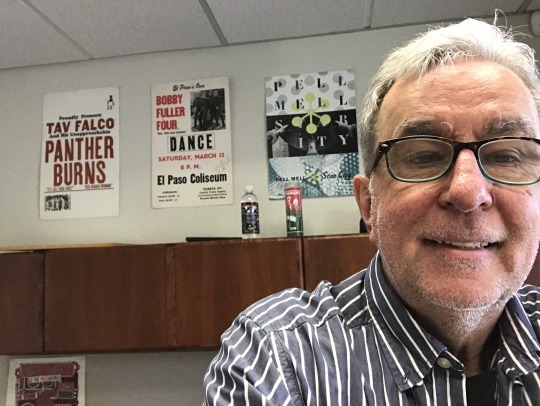
Tav, Bobby, Pell Mell and Ray
21 notes
·
View notes
Text
BLOGTOBER 10/23 & 10/25/2018: HALLOWEEN (2007) & HALLOWEEN II (2009)
By the time Rob Zombie made the bold move of remaking John Carpenter’s name-making classic HALLOWEEN, the horror rock-star’s directorial career had already proved to be incredibly divisive. His 2003 film debut, HOUSE OF 1,000 CORPSES drew a cult from among diehard fans of his music, but was largely panned by critics who identified it as a ramshackle, self-indulgent disaster. The movie was little more than a Frankensteining-together of Zombie’s favorite things, but he managed to follow it up swiftly with 2005′s semi-sequel, THE DEVIL’S REJECTS. With this project, he appropriated three of the principle characters from his cartoony, ROCKY HORROR PICTURE SHOW-like first feature, and reimagined them as the redneck antiheroes of a story that plays like a cross between THE TEXAS CHAIN SAW MASSACRE and THE WILD BUNCH. While DEVIL’S REJECTS showed major improvements in terms of drive and focus, it still felt unsettled. It is an emotionally confused movie that has trouble deciding whether its tale is more tragic for the innocent victims of its psychopathic protagonists, or more triumphant, for the Rejects’ anti-establishment swagger and charisma. Rob Zombie displays a refined aesthetic sense, and seems sincere in his storytelling, but he didn’t have much time to let these things ferment into a more potent cinematic brew before he stepped up to bat again with his controversial remake of the beloved HALLOWEEN in 2007.
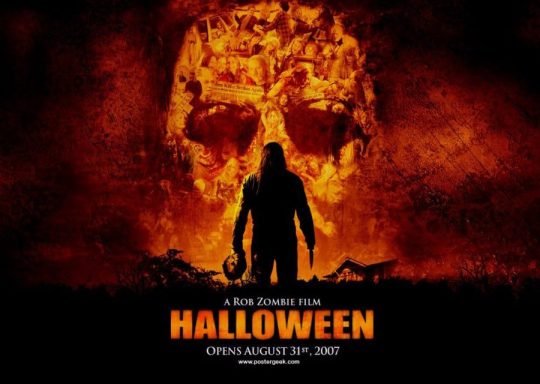
Reviled even by the likes of John Carpenter himself, Zombie’s dour, ponderous retelling of the archetypal slasher story was baffling to critics and genre buffs alike. Loaded up with clunky psychoanalysis that flies in the face of Carpenter’s original intention--Michael Myers is PURE NO-REASON EVIL, FULL STOP--this iteration of HALLOWEEN worked for few people besides Zombie’s hardcore stans. In spite of that very large and general problem, the writer-director was back again in 2009 with a sequel to his own remake. With HALLOWEEN II, he took two major creative risks: Bringing the ubiquitous Sheri Moon Zombie back even though her character died early in the first film, and centering the narrative on Laurie Strode’s psychological recovery, or lack thereof, from her original ordeal. It is easy to see how this setup would draw more complex and ambivalent responses. Mrs. Zombie’s appearance as the ghost of Myers’ mother, whose character is plagued by a lot of Jungian nonsense, was identified fairly as ludicrous by many viewers. On the other hand, Scout Taylor-Compton’s return as Laurie Strode takes a character who was little more than a cardboard cutout in the first film, and turns her into a convincing mass of trauma who undergoes a profound transformation over the course of this sequel. As with THE DEVIL’S REJECTS, HALLOWEEN II suggests that even while Rob Zombie can be an incredibly frustrating filmmaker, he still seems to be on to something. Even in my most stuck-up moments, when his smug use of slow motion and arias of unshocking cuss words make me want to forget everything I just watched, his movies nag at me in a way that I have a hard time describing. I’m just now starting to formulate an understanding of why.

Often, I find myself asking: Who is Rob Zombie? First and foremost, he is a professional nerd. His music, art, videos, and feature films are strung together by his scholarship in all things genre, whether he’s invoking Tobe Hooper’s snuff-like realism, or the innocent sitcom pleasures of the Munsters. Zombie is vastly erudite about horror, and really anything remotely culty. This is actually to the detriment of HOUSE OF 1,000 CORPSES, which is so bloated with pop culture references that it almost chokes out the movie’s dubious originality. But while he has that irritating nerdy compulsion to competitively show off what he knows, he doesn’t seem like the kind of guy who buys and bags comics without even cracking them open. Rob Zombie is clearly, legitimately passionate; it’s heartwarming, and enough to make you want to root for him even when you don’t totally love what he’s doing. His craftsmanship is on point, too, as a multimedia artist whose talent has been abundantly evident since the early band flyer days. It comes as no surprise that he attended Parsons School of Design, and he occasionally shows his hand as an amateur film historian with a love for golden age Hollywood. So, whatever he wants you to think about his hellbilly stage presence, he’s clearly no hick, and no basement-dwelling dweeb either. He’s an educated artist with a background in New York City’s brainy ‘80s noise rock scene. It’s because of this that I find the worshipful attitude his films take toward their sociopathic murderers to be, well...kind of annoying. Why am I supposed to think it’s so cool, as the movies’ punk rock tone suggests, that the Firefly family tortures random bystanders to death for no apparent reason? Why doesn’t Rob Zombie know how tired the whole “scary clown” thing is, and has been for a long time already, even when it’s someone as magical as Sid Haig under the greasepaint? Why do I feel like Zombie’s interest in pimps and ho’s is deeper than just exploitation pastiche, which makes it potentially worse than if it were just a shallow affectation? The thought of this Massachusetts-born college boy fantasizing obsessively about being so crude and violent and salt-of-the-earth is kind of lame. So, instead of just, you know, being a hater as usual, I looked it up--and discovered that Rob Zombie’s roots are actually in the fairway. As Wikipedia aggregates from various interviews:
While raising their sons, Rob's parents worked in a carnival, but they chose to leave after a riot broke out and tents were set on fire. Zombie recalled the experience in an interview, stating, "Everybody's pulling out guns, and you could hear guns going off. I remember this one guy we knew, he was telling us where to go, and some guy just ran up to him and hit him in the face with a hammer – just busted his face wide open. My parents packed up real quick, and we took off."
Suddenly, it all started to make sense. Sure, the costumed popstar isn’t an undead cross between Jerry Lee Lewis and Charles Starkweather in real life, but he isn’t a complete poseur either. It isn’t immediately clear, from underneath his mountain of collectory movie references, that he is, more or less, writing what he knows. He isn’t just emulating his cultural heroes, he’s mythologizing his own childhood.
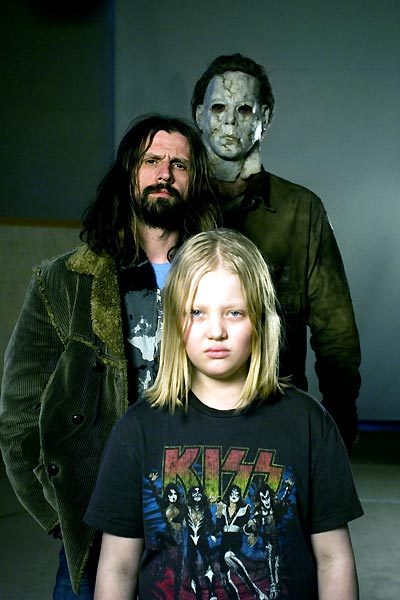
In view of this, the key to Rob Zombie’s movies is not an awareness of horror history and semiology; it’s actually all about outlaw culture. So, back to 2007′s deeply flawed HALLOWEEN. It’s a heavily bro-y movie, in its outsidery way, that breaks up the Dr. Loomis-Michael Myers-Laurie Strode love triangle, and focuses almost entirely on building a Myers biography. The fascinatingly sullen Daeg Neergaard Faerch plays young Michael, a fatherless boy on the verge of snapping from the relentless torment coming at him from all directions: his slutty sister, school bullies who fixate on his stripper mom (Sheri Moon Zombie), and his mother’s latest violent, depraved boyfriend. Michael follows the serial killer script perfectly, graduating rapidly from torturing animals to brutalizing other kids to annihilating his sister, her boyfriend, and his mother’s beau one Halloween night when his sibling chooses sex over taking her little brother trick-or-treating. He soon finds himself installed in a mental institution where he moves on to slaughtering the staff. Dr. Loomis (Malcolm McDowell) spends years evaluating the boy, though he is ultimately stymied by Michael’s profound lack of humanity. As Michael increasingly retreats behind the folksy homemade masks he spends all day crafting, the opportunistic Loomis gives up on him, instead committing his energy to a money-making true crime/pop psychology book about Myers. Flashing forward, we find the hulking adult Michael Myers (played by the 6′8″ wrestler Tyler Mane) getting ready to bust out of the asylum and wage war on his home town of Haddonfield. There we finally meet teen dream Laurie Strode, a spunky babysitter with a gaggle of gal pals who are perfect grist for the slasher mill. In the final leg of the film, Myers carves his way through Laurie’s social circle, in an apparent attempt to reunite with his sister: Laurie herself. Sheriff Brackett (Brad Dourif) reveals that when Michael’s despairing mother committed suicide years ago, he took her infant daughter and had her adopted out anonymously to insulate her from her family’s tragic history. Laurie, for her part, is unaware of anything other than her need to survive, which she only barely accomplishes.
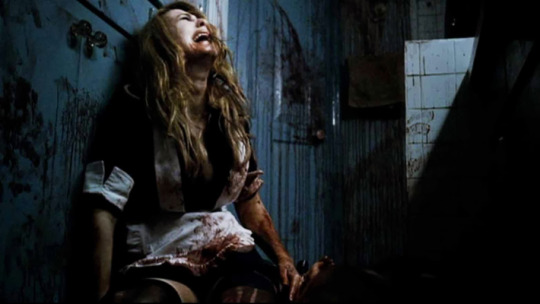
Naturally, Laurie’s story is the weakest part of a movie that is otherwise so focused on male experience. That is, the experience of needing a father, the ambivalent and ambiguous craving for maternal intimacy, the trauma of having your masculinity impugned by your (fag-obsessed) peers, and perhaps even the undermining influence of academia and capitalism on a man’s natural-born strength and worth. When the newly-freed Michael Myers storms through a truck stop to begin his pilgrimage to Haddonfield, and Rob Zombie chooses to accompany this scene with Rush’s regal outlaw anthem “Tom Sawyer”, it tells you everything you need to know about this take on HALLOWEEN. Like the rampaging Firefly family in DEVIL’S REJECTS, Michael is certainly evil, but he also represents something essential about the formation of and reinforcement of one’s individuality in the face of castrating societal norms--something the carnies among whom Rob Zombie grew up would have found very relatable.
It’s worth noting here that, while the sexuality of the women in Michael’s life plays a role in his distorted development, he is not reacting to their sexuality in and of itself. Michael Myers is not driven by the kind of covetousness that we associate with the archetypal slasher, who gives sexually frustrated male viewers a vicarious thrill by punishing sluts and teases. Michael’s problem is that his mother and sister’s sexuality contributes to his isolation. His classmates use his mother’s profession against him, and that profession keeps her from being able to tuck him in at night. Similarly, Michael doesn’t get to enjoy Halloween with his family and the other neighborhood kids, because his sister is too busy getting laid. Michael is abandoned, even while he still has a home to return to, an outsider even in his own house.
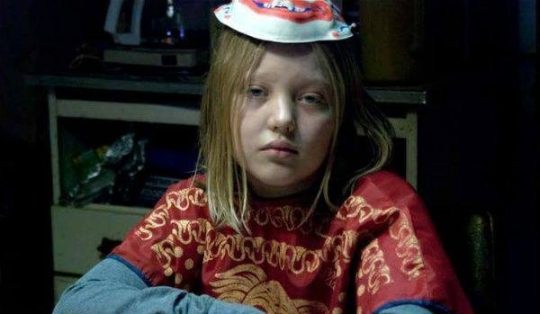
This leads me to an important point about why the portion of the movie that is devoted to Laurie's struggle is so ineffective. It is a flaw in the film, but a virtue of the director: Normal, attractive teenagers are not Rob Zombie’s people. He doesn’t even participate in traditional slasher movie misogyny, he’s so far away from thinking about them. His movies are full of badass women who are fully possessed of their sexuality, and who wield it like a weapon against hypocrites and assholes, and this is always shone in a heroic light. Moreover, he delights in casting women of all shapes and ages, often assigning them immense personal power, as in LORDS OF SALEM, an enormously satisfying movie about society’s original persecuted outcasts: witches. Rob Zombie is deeply committed to outsiders, and his definition of them isn’t limited to banal lawbreaking--he also rejects conventional beauty and our cultural obsession with youth. His films are populated by all manner of human beings, and the farther away they are from looking like model material, the more likely it is that they’re meant to be the heroes. On that note, whatever you think of his movies, you have to acknowledge that they are almost never dehumanizing. Zombie is an accomplished actor’s director who gets a full spectrum of emotion out of his performers, and who excels at creating a feeling of camaraderie within his ensemble casts. It is this surprising sweetness, and compassion even for the victims of the villains he lionizes, that makes HALLOWEEN II so peculiarly effective.
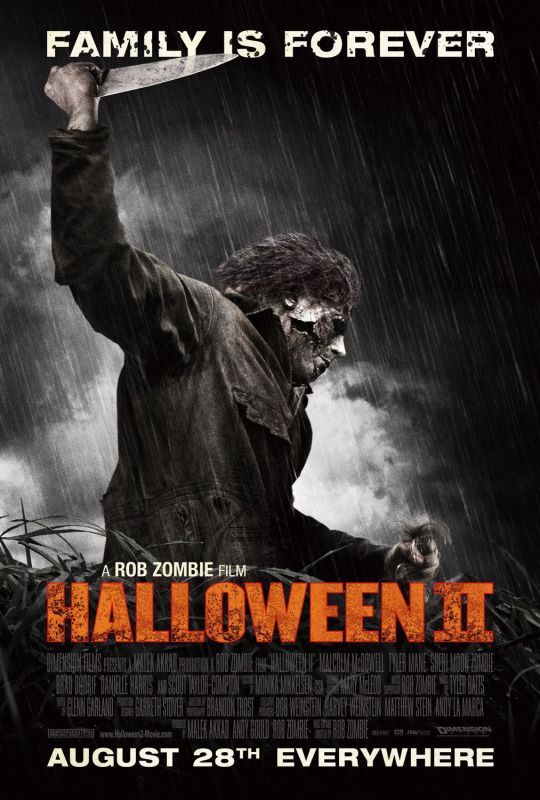
If 2007′s HALLOWEEN was a remake on which Rob Zombie couldn’t resist draping some of his personal hangups, HALLOWEEN II is almost a completely original and separate entity from what one thinks of as the franchise started by John Carpenter. In it, Michael Myers is presumed dead but his body is missing--and indeed, his character is missing for much of the movie. We find a disturbed, scarred-up Laurie Strode living with her surviving friend Annie, and Annie’s father, Sheriff Bracket. Laurie is dealing, poorly, with a heavy dose of PTSD. Along with nightmares and flashbacks, she also has trouble just being nice to people, or accepting affection. Annie and her father’s attempts to be charitable with their adoptive family member are no match for Laurie’s increasing surliness and mistrust of the world. Once a good-natured and optimistic young woman, her appearance becomes vagrant-like (curiously similar to Rob Zombie’s own casual look), her attitude is more and more nihilistic, and she develops a drinking problem. I’ve always wanted to see a movie with a slasher-like narrative foundation, but that focuses on aftermath and recovery, and recent gimmicky efforts like FINAL GIRL and LAST GIRL STANDING did absolutely nothing for me. HALLOWEEN II--at least, the superbly-acted Strode part of it--is the movie I’ve been asking for.
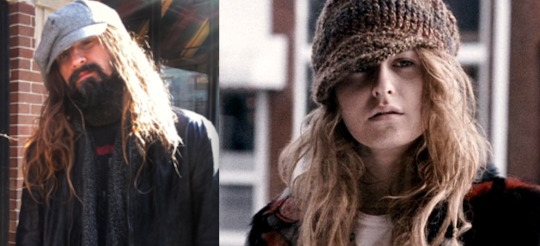
The other part of the movie is also interesting--or more specifically, it’s as ballsy as it is flawed. The movie gets off on kind of a bad foot when a title card quotes an obscure psychology text book called The Subconscious Psychosis of Dreams:
WHITE HORSE - instinct, purity, and the drive of the physical body to release powerful and emotional forces, like rage with ensuing chaos and destruction.
This is the excuse we have for the fact that the ghost of Deborah Myers arrives with a white horse to compel her son to find his sister Laurie Strode, aka Angel Myers, to reunite their family, presumably in the afterlife. Deborah Myers is kind of a spectral cross between Glenda the Good Witch and the Wicked Witch of the West, at once welcoming and sinister, drifting in and out of Michael’s consciousness in the company of a sort of ghost of his childhood (Chase White Vaneck, who is no Daeg Faerch honestly). It might be easy to dismiss this anomaly as an expression of Michael’s mental illness, and his desire to experience an idealized version of his youth in which his mother still looks after him--except that later in the movie, during the final standoff, Laurie is shown to be physically affected by these spirits. Maybe the implication is that she and Michael suffer the same psychological ailments, but for them to share such specific hallucinations without speaking is borderline supernatural in and of itself. So, while Sheri Moon Zombie does her best with her impressive force of personality and compelling physical presence, it’s hard to say what this part of the movie serves. When I first saw the film, I was completely outraged by this, not only because it made no sense to me, but because it felt like a cheap ripoff of Sarah Palmer’s similar prophetic visions of a white horse in Twin Peaks. That was all I managed to make of it.
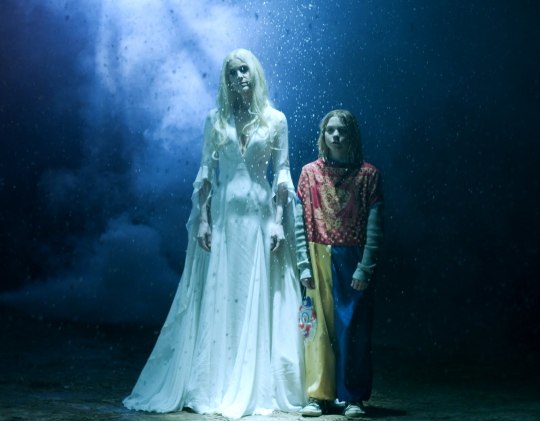
Today, I still don’t love it, but I have more trouble faulting Rob Zombie for trying to make HALLOWEEN his own, something more than a remake. He also does this by truly letting go of the Shape. The famous William Shatner mask was blown in half by Laurie at the end of the 2007 HALLOWEEN, and scarcely makes much of an appearance in this movie. Michael Myers is a disheveled drifter, literally haunted by his past, whose only real aim is to find a place to belong. It’s sort of funny, in retrospect: When John Carpenter made the first HALLOWEEN, he-by-way-of-Dr. Loomis declared Michael an empty shell of a person, someone who was simply born evil, as reflected by the empty-eyed mask he wears. For some reason, though, a whole legacy of directors just couldn’t resist trying to explain Myers away. The original HALLOWEEN II then says, “Well...what if Michael Myers is on a rampage because LAURIE STRODE IS HIS SISTER? What’s that you say? Why is that a reason to rampage? Ummmm...” And then HALLOWEEN 4 sees him pursuing other young female relations of his, and then in subsequent movies there’s an accursed rune, and druids, and immortality rites, and by the time you get to HALLOWEEN 6 you have this absurd stone soup of bad ideas. It’s a miracle that this franchise became such a thing. Rob Zombie makes the same fundamental mistake, but at least he tries it in the simplest possible way, asserting plainly that Nurture, not Nature, made Michael into a killer. Now, terminally lonely, he’s like a clown waking up in his trailer to find that the carnival left without him. Exiled from mainstream society, he seeks out what remains of his family, who, due to his own violent actions, has grown up more like him than he may have imagined.
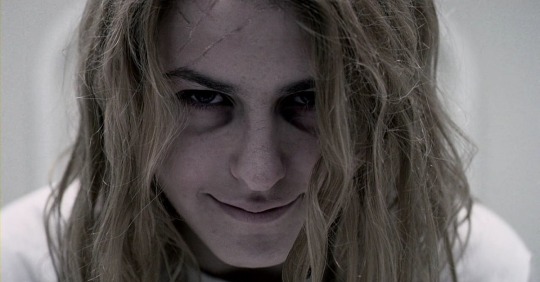
I’m not saying I think this was the best thing to do with HALLOWEEN 2. Personally, what I crave in horror movies is something that is farther beyond explanation than this--something that gesturally resembles my life experience, but that plunges past the veil of mundanity into a deeper, darker world of primordial fears and urges, addressing things that unsettle me because I cannot rationalize them. For me, horror is definitionally incomprehensible, and Rob Zombie’s HALLOWEEN diptych is fundamentally sane. But, I think what I’ve discovered is that these movies are not proper horror movies, in spite of their relentless sadistic violence. They are outlaw fables, with more DNA in common with something like EASY RIDER, than with FRIDAY THE 13TH. It’s funny to watch myself coming to a compassionate understanding of these movies that are themselves about outsiders and rejects who are specifically deprived of understanding. My goal in all this was not so much to convince people of the value of these movies, which one might reject on any number of reasonable counts, but to explain to myself why I keep coming back to them. It isn’t to condescendingly heckle them, and it isn’t just because they’re often handsome-looking, or because they’re so emotionally authentic even when the narrative is less than compelling. It must be because, even when I’ve found him challenging, I can’t help seeing Rob Zombie as a person with vision, someone who heroically eschews common consensus on taste and sense-making--the consensus even among horror fans and his own cinematic heroes--in order to say what makes sense to him personally. Finally, he has begun to make sense to me, too.

#rob zombie#halloween#2007#halloween ii#2009#blogtober#remake#John Carpenter#sheri moon zombie#michael myers#laurie strode#scout taylor-compton#brad dourif#malcolm mcdowell#tyler mane#the shape#horror#slasher#outlaw culture
147 notes
·
View notes
Photo

“The Road to Rock n’ Roll - Guitars”
Date: March 14, 2019
© Scott Fraser Photography
Dedicated to Rod Coulter. The first guitarist in my life.
In 1971 legendary guitar player and song writer Alvin Lee wrote the song “I’d Love to Change the World”. I was born in 1970, so it’s before my time. But I did grow up listening to it, thanks to three amazing uncles. In 1994, the Sunset Strip based band, L.A. Guns released a cover of it on their album Vicious Circles. With all respect to Alvin Lee, I prefer Tracii Guns’ version of the song. It’s got an edge to it. It touches my soul. Tracii’s chops, his notes, pure, clean, defined, at times ethereal, and delivered with a punch - I can’t help myself, but smile. I end up air guitaring to it every time. In my head I see his fingers on the fretboard, and his other hand as he strums and picks. I see the body of the guitar, the pick-ups, the dials. In my head while I am listening, Tracii is playing live on stage, and I am front-row right in front of him, soaking up with every sense, the moment.
But let’s back up a bit.
1975 was a seminal year for me. It was the year I decided I wanted to play drums, and it was the year I took an active interest in photography. I was five at the time. Thanks to the music of Brian Wilson and the Beach Boys, and a couple of photographers named Linda McCartney and L.A. based photographer Greg Papazian.
Uncle Art was cool enough to allow this little kid, hang out with him and his friends. CHOM FM would play in the background while Art and his friends would flip through rock magazines. Here I was this five year old kid hanging out with a bunch of fifteen to twenty year olds, while they chilled, played cards and listening to music. I loved it, it was my sanctuary. I would sit quietly out of the way, and just listen as they talked about the music playing, and the photographs in the magazines. They would discuss for hours on end the merit of this song, or that song. Who played it better? The meaning of the lyrics, how “deep” a note went, the crunch of the electric guitar. How cool so and so looked in that shot. And they would ask me what I thought, including me in the conversations. They were teens in the mid seventies in Montreal, had long hair, and cool clothes. Leather jackets and denim, like their heroes in the bands they listened to. That bedroom in that little house on the east end of Montreal is where my rock n’ roll journey began.
In the fall of 1975 I would buy my first albums at a local record store. I knew I wanted a Beach Boy album, and I had enough money saved up to buy a second album. I had hoped that Art would come along to advise me as to what to buy because I wanted something that wasn’t my mom and dad’s music. I wanted something like the music I heard on the FM station and like what Art and his friends listened to. I ended up purchasing a K-Tel album with a bunch of different bands playing songs on it. I figured it was the best way to own new music.The first song I fell i love with on that record was “Smoking’ In The Boys Room” by Brownsville Station. I had hoped when I bought the album that I would have new songs to play my drums along to. But it was the guitar playing that caught my attention. The twang, the rhythm and the way it sounded. Yeah, I loved the drums in it as well, but it really did catch my attention because of the guitar. It’s a balls out blues tune done rock n’ roll.
The music photography of the early seventies until the late1980’s would show case some of the best photography ever done. Before the internet and modern social media, bands and musicians used photographs in magazines to define their image and look. The record labels had long ago realized you could sell more records if your band was being showcased in a music magazine. It was also the era of the fanzine as independent writers, journalists and photographers documented the local scene. It was the era as a teen that you hung posters of the bands you loved on your bedroom walls. And many went a step further, like myself, cutting photos out of magazines to pin to on our walls. Punk and Metal came of age, and Generation X grew into teens and young adults. Raised on the photographs, posters and the FM waves we grew into young adults as we searched for our own identities. Static images had been our visual medium of consumption, that is until video came along and killed a radio star.
As a teenager I got five dollars a week allowance, so it would take me three weeks of saving to buy a new album which was anywhere from ten to fifteen dollars. Birthday, christmas or any gift money went towards music. In a month I could save and buy one album and one to two rock magazines. Babysitting and odd jobs were a means to an end. It was an era where a lot of the time that meant I bought an album without hearing more than one song on it. Other times you bought because you had liked the artwork, or photos on the album cover. Or maybe your friends had talked about it, or you had read about it in Circus or Hit Parader magazine.
My friends and I would make agreements as to who bought what album so that we could get together and share them. I’d buy Metallica, Rod would buy Ozzy Osbourne, Jay would buy Def Leppard. My friends and I would trade albums with one another so that each of us, could get a chance to hear new music. You went out and bought the albums for yourself so that you could look at the photos, the artwork, and the credits and if you were lucky, the lyrics while listening to the album play. You went to concerts and bought T-shirts, posters, back patches and tour books and when you got home from the concert, you’d share it all with your friends the following day.
Back to the guitar…
I’m a Randy Rhoads guy. Yes, I appreciate what Jimi Hendrix did. But I prefer the sound, the tones and the classical influence of Randy’s playing. Randy was a metal/hard-rock/classical guitarist. Those iconic photos of him with his Les Paul and Jackson V are forever burned into my memory. That first time I heard Crazy Train by Ozzy off of the Blizzard of Ozz album, I was blown away. In that moment I knew I would never ever play that good, and I was okay with that. I didn’t have to. I knew right then and there, I wanted to either play in bands and with people who could play like that, or somehow be part of the scene. Maybe I would be a roadie, maybe a guitar tech, maybe a lighting guy. I didn’t care what I did, as long as I was part of it. Over the years I played in bands, worked as a lighting tech, help promote shows and gigs, created gig posters, designed album covers and T-shirts, and have done roadie more than I care to admit.
To this day I can’t play guitar to save my life. That is on me. I have owned some beautiful guitars over the years including a 1986 USA made Kramer, but I never put the time and effort in to really learn. There was always something else I wanted to do, and I liked singing, so I would work on vocals. I did however fill my life with guitar players. Starting with Rod Coulter who had been a childhood friend and it has continued to players like Benny Kemp who plays in a rising speed metal band Roadrash. They are my friends, they are people I call Brother and Sister, they are my Rock n’ Roll Family. They have been my mentors and others have been my protege. We’re a family and I am so grateful for that.
At fourty-eight years of age, I still love my music loud. I love my punk more than ever, and am still listening to my metal. I still air guitar along to the songs I love. If I know the words odds are I am going to be singing along. I still think of putting a band together form time to time and recording album, maybe one day I will. These days though, I am happy to be the Photographer. I love photographing musicians and their instruments. I am an editorial music photographer. I’m there to document the moment and in the process make the musicians look good. I am shooting first and foremost for the musicians. I am also an artist, so i want to have something that means something to myself as well as the musician in question.
At this stage in my life my photographs have been published in music magazines, used as album covers, album art work, promo posters and T-shirts. I’d like to think I have my own style, and I thank my mentors for taking the time to teach me how to do what I now do so well. Thank you Mike, Scott, Greg and Frank - my shots wouldn’t be what they are without your tutelage.
Guitars the photographic series, is my tribute to the instruments first created by Leo Fender and Les Paul all those years ago. It’s about the players and the instruments that define rock music. The photographs within the series is for the musicians who play the notes. It may just be “a piece of wood, with six metal strings” but in the hands of a musician who knows how to play, it is tool of magic. It’s my attempt as an artist to create a visual representation of the moment, the energy, the sound being played. To capture in colour and monochrome, the feel of it all, at that moment the music is playing. The use of noise and grain to match the distortion and saturation of the Marshall amps. It is my humble attempt as an artist to say Thank You.
You can look at the photographs without music playing, but it’s better if you have the song turned up.
Playlist:
L.A. Guns - I’d Love to Change The World
https://www.youtube.com/watch?v=TSog8WmD6uQ
Brownsville Station - Smoking’ In The Boys Room
https://www.youtube.com/watch?v=5K59EMGgrUA
Kiss - Detroit Rock City
https://www.youtube.com/watch?v=iZq3i94mSsQ
Ozzy Osbourne - Crazy Train
https://www.youtube.com/watch?v=vy1V5LHXWbg
Ozzy Osbourne - Mr. Crowley (live 1981)
https://www.youtube.com/watch?v=G3LvhdFEOqs
April Wine - Don’t Push Me Around
https://www.youtube.com/watch?v=wWiU8rkA_yU
Alvin Lee - Detroit Diesel
https://www.youtube.com/watch?v=uXedZ_EsI_4
Savage - Handful of Rain
https://www.youtube.com/watch?v=x7EeM2AK1gA
Toccata - Carpimus Noctem
https://www.youtube.com/watch?v=XOANxP5ZvuY
Megadeth - Tornado of Souls
https://www.youtube.com/watch?v=Lcm9qqo_qB0
Joe Satriani - Always With Me, Always With You
https://www.youtube.com/watch?v=VI57QHL6ge0
Social Distortion - Prison Bound (live)
https://www.youtube.com/watch?v=lIWHlIhvt3Y
1 note
·
View note